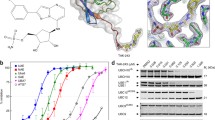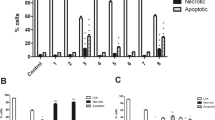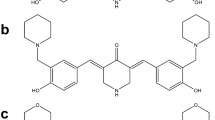Summary
Gambogic acid (GA), displays cytotoxicity towards a wide variety of tumor cells and has been shown to affect many important cell-signaling pathways. In the present work, we investigated the mechanism of action of GA by analysis of drug-induced changes in gene expression profiles and identified GA and the derivative dihydro GA as possible inhibitors of the ubiquitin-proteasome system (UPS). Both GA and dihydro GA inhibited proteasome function in cells resulting in the accumulation of polyubiquitin complexes. In vitro experiments showed that both GA and dihydro GA inhibited 20S chymotrypsin activity and the inhibitory effects of GA and dihydro GA on proteasome function corresponded with apoptosis induction and cell death. In conclusion, our results show that GA and dihydro GA exert their cytotoxic activity through inhibition of the UPS, specifically by acting as inhibitors of the chymotrypsin activity of the 20S proteasome.







Similar content being viewed by others
References
Cragg GM, Grothaus PG, Newman DJ (2009) Impact of natural products on developing new anti-cancer agents. Chem Rev 109:3012–3043
Chen J, Gu HY, Lu N, Yang Y, Liu W, Qi Q, Rong JJ, Wang XT, You QD, Guo QL (2008) Microtubule depolymerization and phosphorylation of c-Jun N-terminal kinase-1 and p38 were involved in gambogic acid induced cell cycle arrest and apoptosis in human breast carcinoma MCF-7 cells. Life Sci 83:103–109
Zhang HZ, Kasibhatla S, Wang Y, Herich J, Guastella J, Tseng B, Drewe J, Cai SX (2004) Discovery, characterization and SAR of gambogic acid as a potent apoptosis inducer by a HTS assay. Bioorg Med Chem 12:309–317
Reutrakul V, Anantachoke N, Pohmakotr M, Jaipetch T, Sophasan S, Yoosook C, Kasisit J, Napaswat C, Santisuk T, Tuchinda P (2007) Cytotoxic and anti-HIV-1 caged xanthones from the resin and fruits of Garcinia hanburyi. Planta Med 73:33–40
Wu ZQ, Guo QL, You QD, Zhao L, Gu HY (2004) Gambogic acid inhibits proliferation of human lung carcinoma SPC-A1 cells in vivo and in vitro and represses telomerase activity and telomerase reverse transcriptase mRNA expression in the cells. Biol Pharm Bull 27:1769–1774
Yi T, Yi Z, Cho SG, Luo J, Pandey MK, Aggarwal BB, Liu M (2008) Gambogic acid inhibits angiogenesis and prostate tumor growth by suppressing vascular endothelial growth factor receptor 2 signaling. Cancer Res 68:1843–1850
Qi Q, Gu H, Yang Y, Lu N, Zhao J, Liu W, Ling H, You QD, Wang X, Guo Q (2008) Involvement of matrix metalloproteinase 2 and 9 in gambogic acid induced suppression of MDA-MB-435 human breast carcinoma cell lung metastasis. J Mol Med 86:1367–1377
Qin Y, Meng L, Hu C, Duan W, Zuo Z, Lin L, Zhang X, Ding J (2007) Gambogic acid inhibits the catalytic activity of human topoisomerase IIalpha by binding to its ATPase domain. Mol Cancer Ther 6:2429–2440
Pandey MK, Sung B, Ahn KS, Kunnumakkara AB, Chaturvedi MM, Aggarwal BB (2007) Gambogic acid, a novel ligand for transferrin receptor, potentiates TNF-induced apoptosis through modulation of the nuclear factor-kappaB signaling pathway. Blood 110:3517–3525
Zhai D, Jin C, Shiau CW, Kitada S, Satterthwait AC, Reed JC (2008) Gambogic acid is an antagonist of antiapoptotic Bcl-2 family proteins. Mol Cancer Ther 7:1639–1646
Cvek B, Dvorak Z (2011) The ubiquitin-proteasome system (UPS) and the mechanism of action of bortezomib. Curr Pharm Des 17:1483–1499
Tsukamoto S, Yokosawa H (2009) Targeting the proteasome pathway. Expert Opin Ther Targets 13:605–621
Adams J (2004) The proteasome: a suitable antineoplastic target. Nat Rev Cancer 4:349–360
Peters JM, Cejka Z, Harris JR, Kleinschmidt JA, Baumeister W (1993) Structural features of the 26 S proteasome complex. J Mol Biol 234:932–937
da Fonseca PC, He J, Morris EP (2012) Molecular model of the human 26S proteasome. Mol Cell 46:54–66
An B, Goldfarb RH, Siman R, Dou QP (1998) Novel dipeptidyl proteasome inhibitors overceome Bcl-2 protective function and selectively acculmulate the cyclin-dependent kinase inhibitor p27 and induce apoptosis in transformed, but not normal, human fibroblasts. Cell Death Differ 5:1062–1975
Hideshima T, Richardson P, Chauhan D, Palombella VJ, Elliott PJ, Adams J, Anderson KC (2001) The protesaome inhibitor PS-341 inhibits growth, induces apoptosis, and overcomes drug resitance in human multiple myeloma cells. Cancer Res. 61
Tsukamoto S, Yokosawa H (2010) Inhibition of the ubiquitin-proteasome system by natural products for cancer therapy. Planta Med 76:1064–1074
Potts BC, Albitar MX, Anderson KC, Baritaki S, Berkers C, Bonavida B, Chandra J, Chauhan D, Cusack JC, Fenical W, Ghobiral IM, Groll M, Jensen PR, Lam KS, Lloyd GK, McBride W, McConkey DJ, Miller CP, Neuteboom STC, Oki Y, Ovaa H, Pajonk F, Richardson PG, Roccaro AM, Sloss CM, Spear MA, Valashi E, Younes A, Palladino MA (2011) Marizomib, a proteasome inhibitor for all seasons: preclinical profile and a framework for clinical trials. Curr Cancer Drug Targets 11:254–284
Kuhn DJ, Orlowski RZ, Bjorklund CC (2011) Second generation proteasome inhibitors: carfilzomib and Immunoproteasome-Specific Inhibitors (IPSIs). Curr Cancer Drug Targets 11:285–295
Yang H, Landis-Piwowar K, Chan TH, Dou QP (2011) Green tea polyphenols as proteasome inhibitors: implication in chemoprevention. Curr Cancer Drug Targets 11:296–306
Cecarini V, Cuccioloni M, Mozzicafreddo M, Bonfili L, Angeletti M, Eleuteri AM (2011) Targeting proteasome with naturally occurring compounds in cancer treatment. Curr Cancer Drug Targets 11:307–324
Rickardson L, Wickstrom M, Larsson R, Lovborg H (2007) Image-based screening for the identification of novel proteasome inhibitors. J Biomol Screen 12:203–210
Lavelin I, Beer A, Kam Z, Rotter V, Oren M, Navon A, Geiger B (2009) Discovery of novel proteasome inhibitors using a high-content cell-based screening system. PLoS One 4:e8503
Menendez-Benito V, Verhoef LG, Masucci MG, Dantuma NP (2005) Endoplasmic reticulum stress compromises the ubiquitin-proteasome system. Hum Mol Genet 14:2787–2799
Dhar S, Nygren P, Csoka K, Botling J, Nilsson K, Larsson R (1996) Anti-cancer drug characterisation using a human cell line panel representing defined types of drug resistance. Br J Cancer 74:888–896
Rickardson L, Fryknas M, Dhar S, Lovborg H, Gullbo J, Rydaker M, Nygren P, Gustafsson MG, Larsson R, Isaksson A (2005) Identification of molecular mechanisms for cellular drug resistance by combining drug activity and gene expression profiles. Br J Cancer 93:483–492
Lamb J, Crawford ED, Peck D, Modell JW, Blat IC, Wrobel MJ, Lerner J, Brunet JP, Subramanian A, Ross KN, Reich M, Hieronymus H, Wei G, Armstrong SA, Haggarty SJ, Clemons PA, Wei R, Carr SA, Lander ES, Golub TR (2006) The Connectivity Map: using gene-expression signatures to connect small molecules, genes, and disease. Science 313:1929–1935
Fayad W, Fryknas M, Brnjic S, Olofsson MH, Larsson R, Linder S (2009) Identification of a novel topoisomerase inhibitor effective in cells overexpressing drug efflux transporters. PLoS One 4:e7238
Larsson R, Nygren P (1989) A rapid fluorometric method for semiautomated determination of cytotoxicity and cellular proliferation of human tumor cell lines in microculture. Anticancer Res 9:1111–1119
Lindhagen E, Nygren P, Larsson R (2008) The fluorometric microculture cytotoxicity assay. Nat Protoc 3:1364–1369
Paull KD, Shoemaker RH, Hodes L, Monks A, Scudiero DA, Rubinstein L, Plowman J, Boyd MR (1989) Display and analysis of patterns of differential activity of drugs against human tumor cell lines: development of mean graph and COMPARE algorithm. J Natl Cancer Inst 81:1088–1092
Shibata T, Yamada T, Kondo M, Tanahashi N, Tanaka K, Nakamura H, Masutani H, Yodoi J, Uchida K (2003) An endogenous electrophile that modulates the regulatory mechanism of protein turnover: inhibitory effects of 15-deoxy-Delta 12,14-prostaglandin J2 on proteasome. Biochemistry 42:13960–13968
Yang H, Chen D, Cui QC, Yuan X, Dou QP (2006) Celastrol, a triterpene extracted from the Chinese "Thunder of God Vine," is a potent proteasome inhibitor and suppresses human prostate cancer growth in nude mice. Cancer Res 66:4758–4765
Yang H, Shi G, Dou QP (2007) The tumor proteasome is a primary target for the natural anticancer compound Withaferin A isolated from "Indian winter cherry". Mol Pharmacol 71:426–437
Lovborg H, Oberg F, Rickardson L, Gullbo J, Nygren P, Larsson R (2006) Inhibition of proteasome activity, nuclear factor-KappaB translocation and cell survival by the antialcoholism drug disulfiram. Int J Cancer 118:1577–1580
Zimmermann J, Erdmann D, Lalande I, Grossenbacher R, Noorani M, Furst P (2000) Proteasome inhibitor induced gene expression profiles reveal overexpression of transcriptional regulators ATF3, GADD153 and MAD1. Oncogene 19:2913–2920
Yew EH, Cheung NS, Choy MS, Qi RZ, Lee AY, Peng ZF, Melendez AJ, Manikandan J, Koay ES, Chiu LL, Ng WL, Whiteman M, Kandiah J, Halliwell B (2005) Proteasome inhibition by lactacystin in primary neuronal cells induces both potentially neuroprotective and pro-apoptotic transcriptional responses: a microarray analysis. J Neurochem 94:943–956
Mitsiades N, Mitsiades CS, Poulaki V, Chauhan D, Fanourakis G, Gu X, Bailey C, Joseph M, Libermann TA, Treon SP, Munshi NC, Richardson PG, Hideshima T, Anderson KC (2002) Molecular sequelae of proteasome inhibition in human multiple myeloma cells. Proc Natl Acad Sci USA 99:14374–14379
Fribley A, Zeng Q, Wang CY (2004) Proteasome inhibitor PS-341 induces apoptosis through induction of endoplasmic reticulum stress-reactive oxygen species in head and neck squamous cell carcinoma cells. Mol Cell Biol 24:9695–9704
Hong SH, Kim J, Kim JM, Lee SY, Shin DS, Son KH, Han DC, Sung YK, Kwon BM (2007) Apoptosis induction of 2'-hydroxycinnamaldehyde as a proteasome inhibitor is associated with ER stress and mitochondrial perturbation in cancer cells. Biochem Pharmacol 74:557–565
Noonan EJ, Place RF, Giardina C, Hightower LE (2007) Hsp70B' regulation and function. Cell Stress Chaperones 12:393–402
Wu WT, Chi KH, Ho FM, Tsao WC, Lin WW (2004) Proteasome inhibitors up-regulate haem oxygenase-1 gene expression: requirement of p38 MAPK (mitogen-activated protein kinase) activation but not of NF-kappaB (nuclear factor kappaB) inhibition. Biochem J 379:587–593
Shen J, Reis J, Morrison DC, Papasian C, Raghavakaimal S, Kolbert C, Qureshi AA, Vogel SN, Qureshi N (2006) Key inflammatory signaling pathways are regulated by the proteasome. Shock 25:472–484
Tang ZY, Wu YL, Gao SL, Shen HW (2008) Effects of the proteasome inhibitor bortezomib on gene expression profiles of pancreatic cancer cells. J Surg Res 145:111–123
Kinyamu HK, Collins JB, Grissom SF, Hebbar PB, Archer TK (2008) Genome wide transcriptional profiling in breast cancer cells reveals distinct changes in hormone receptor target genes and chromatin modifying enzymes after proteasome inhibition. Mol Carcinog 47:845–885
Kasibhatla S, Jessen KA, Maliartchouk S, Wang JY, English NM, Drewe J, Qiu L, Archer SP, Ponce AE, Sirisoma N, Jiang S, Zhang HZ, Gehlsen KR, Cai SX, Green DR, Tseng B (2005) A role for transferrin receptor in triggering apoptosis when targeted with gambogic acid. Proc Natl Acad Sci USA 102:12095–12100
Kapuria V, Peterson LF, Fang D, Bornmann WG, Talpaz M, Donato NJ (2010) Deubiquitinase inhibition by small-molecule WP1130 triggers aggresome formation and tumor cell apoptosis. Cancer Res 70:9265–9276
Koulich E, Li X, DeMartino GN (2008) Relative structural and functional roles of multiple deubiquitylating proteins associated with mammalian 26S proteasome. Mol Biol Cell 19:1072–1082
D'Arcy P, Brnjic S, Olofsson MH, Fryknas M, Lindsten K, De Cesare M, Perego P, Sadeghi B, Hassan M, Larsson R, Linder S (2011) Inhibition of proteasome deubiquitinating activity as a new cancer therapy. Nat Med 17:1630–1640
Batova A, Altomare D, Chantarasriwong O, Ohlsen KL, Creek KE, Lin YC, Messersmith A, Yu AL, Yu J, Theodorakis EA (2010) The synthetic caged garcinia xanthone cluvenone induces cell stress and apoptosis and has immune modulatory activity. Mol Cancer Ther 9:2869–2878
Guo QL, Lin SS, You QD, Gu HY, Yu J, Zhao L, Qi Q, Liang F, Tan Z, Wang X (2006) Inhibition of human telomerase reverse transcriptase gene expression by gambogic acid in human hepatoma SMMC-7721 cells. Life Sci 78:1238–1245
Zhang L, Yi Y, Chen J, Sun Y, Guo Q, Zheng Z, Song S (2010) Gambogic acid inhibits Hsp90 and deregulates TNF-alpha/NF-kappaB in HeLa cells. Biochem Biophys Res Commun 403:282–287
Davenport J, Manjarrez JR, Peterson L, Krumm B, Blagg BS, Matts RL (2011) Gambogic acid, a natural product inhibitor of Hsp90. J Nat Prod 27:1085–1092
Sethi G, Ahn KS, Pandey MK, Aggarwal BB (2007) Celastrol, a novel triterpene, potentiates TNF-induced apoptosis and suppresses invasion of tumor cells by inhibiting NF-kappaB-regulated gene products and TAK1-mediated NF-kappaB activation. Blood 109:2727–2735
Sartore-Bianchi A, Gasparri F, Galvani A, Nici L, Darnowski JW, Barbone D, Fennell DA, Gaudino G, Porta C, Mutti L (2007) Bortezomib inhibits nuclear factor-kappaB dependent survival and has potent in vivo activity in mesothelioma. Clin Cancer Res 13:5942–5951
Broemer M, Krappmann D, Scheidereit C (2004) Requirement of Hsp90 activity for IkappaB kinase (IKK) biosynthesis and for constitutive and inducible IKK and NF-kappaB activation. Oncogene 23:5378–5386
Sugita T, Tanaka S, Murakami T, Miyoshi H, Ohnuki T (1999) Immunosupressive effects of the heat shock protein 90-binding antibiotic geldanamycin. Biochem Mol Biol Int 47:587–595
Huang H, Chen D, Li S, Li X, Liu N, Lu X, Liu S, Zhao K, Zhao C, Guo H, Yang C, Zhou P, Dong X, Zhang C, Guanmei, Dou QP, Liu J (2011) Gambogic acid enhances proteasome inhibitor-induced anticancer activity. Cancer Lett 301:221–228
Acknowledgments
The authors are very grateful to Professor Nico Dantuma for the kind gift of MelJuSo UbG76V-YFP cells. We also wish to thank Maria Rydåker, Anna Haukkula and Hanna Göransson Kultima at the Uppsala Array Platform for microarray analysis, Sandra Erlund for assistance in the literature survey, and Lena Lenhammar for RNA preparation. This work was supported by unconditional grants from the Lions Cancer Research Fund and a Swedish Institute scholarship for Karolina Lesiak-Mieczkowska.
Conflict of interest
The authors declare that they have no conflict of interest.
Author information
Authors and Affiliations
Corresponding author
Rights and permissions
About this article
Cite this article
Felth, J., Lesiak-Mieczkowska, K., D’Arcy, P. et al. Gambogic acid is cytotoxic to cancer cells through inhibition of the ubiquitin-proteasome system. Invest New Drugs 31, 587–598 (2013). https://doi.org/10.1007/s10637-012-9902-y
Received:
Accepted:
Published:
Issue Date:
DOI: https://doi.org/10.1007/s10637-012-9902-y




